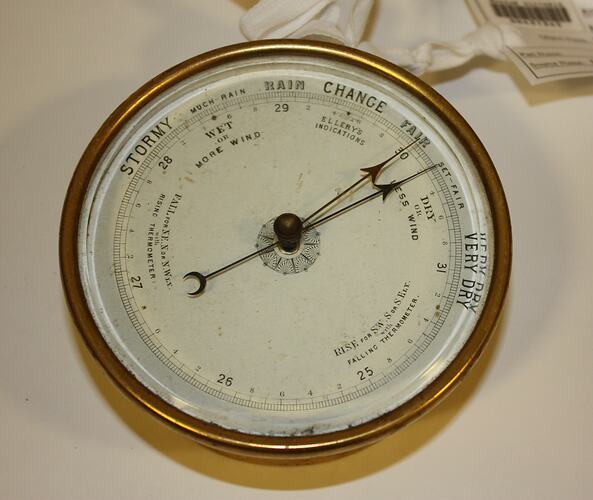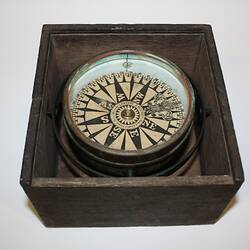Summary
Marine aneroid barometer, 'Ellery's Indications', from the 'Cygnet', dated to the mid-19th century. The barometer was re-plated with 24-carat gold in recent years by a Mr Tunnell-Jones, according to the donor.
The 'Cygnet' was a wooden schooner built in 1846 and owned by William Blakeley. It sank on 31 August 1876 in Port Phillip Bay in a northerly gale (it is said that the master was drunk, which precluded an insurance payout on the wreck). It was later advertised for salvage. (A second schooner, the 'Fear Not,' is also linked to William Blakeley. It was wrecked in 1882.)
Marine barometers are used at sea to monitor atmospheric conditions. Low pressure readings on the barometer indicate unfavourable weather for sailing - such as storms or high winds - whilst high pressure readings indicate favourable sailing conditions. This example is an aneroid barometer, which uses a metal vacuum disc and mechanical arms to measure air pressure. Aneroid barometers were invented in 1840 by Lucien Vidie and eventually replaced the older mercury barometers due to their lower cost and ease of transportation. Aneroid barometers have to be adjusted according to their height above sea level. The 'indications' are based on readings taken at mean sea level. This barometer was most recently calibrated to 600ft above sea level.
Part of a collection of and other material relating to the life of William Henry Blakeley and the Blakeley family donated to Museum Victoria. William Blakeley was the first saw manufacturer in Australia. He was born in England in 1839 and was indentured as a saw maker. In 1867 he set up his own saw shop in Little Bourke Street - soon to become a successful manufacturing business, W.H. Blakeley and Co (which became W.H. and Company Proprietary Limited in 1922), with several locations in inner Melbourne. The Blakeley business has continued into the 21st century.
Physical Description
Aneroid barometer, circular, in circular metal case, with white face (presumably metal, now spotted), black writing, brass hands and glass cover, bevilled around the edge. It has been recently re-plated in gold; however, the rest of the mechanism appears to be original. The position of the needle indicates the type of weather - eg. 'Stormy', 'Dry', according to the direction of the needle. The circular scale on the face has atmospheric pressure gradations from 25 to 31, marked out in tenths (marked every 2) and one-fiftieth units.
More Information
-
Collecting Areas
-
Acquisition Information
Donation from Helen Blakeley, 23 Aug 2012
-
Original Owner
-
Ship Named
-
Date Made
1840-1876
Dates based on invention of aneroid barometer and sinking of the 'Cygnet'. -
Inscriptions
Printed on outer ring of face: 'STORMY / MUCH-RAIN / RAIN / CHANGE / FAIR / SET-FAIR / VERY DRY' Within gradations: 'WET / OR / MORE WIND / DRY OR LESS WIND / FALL FOR N.E.N. OR N.WLY. / with / RISING THERMOMETER / RISE FOR S.W.S. OR S. ELY. / with / FALLING THERMOMETER.' Also marked on face: 'ELLERY'S INDICATIONS'.
-
Classification
Water transport, Ship fittings & auxiliaries, Marine instruments
-
Category
-
Discipline
-
Type of item
-
Overall Dimensions
55 mm (Depth), 124 mm (Outside Diameter)
-
References
'A Brief History of Barometers,' at: [Link 1] accessed: January 23, 2013 'Ship's Bridge Equipment - The Barometer,' at: [Link 2] accessed: January 23, 2013 'Cygnet,' Wrecksite, at: [Link 3] accessed: January 23, 2013 'Cygnet,' Victorian Heritage Database, at: [Link 4] accessed: January 23, 2013
-
Keywords
Barometers, Ships, Ship Accessories, Navigation, Water Transport


